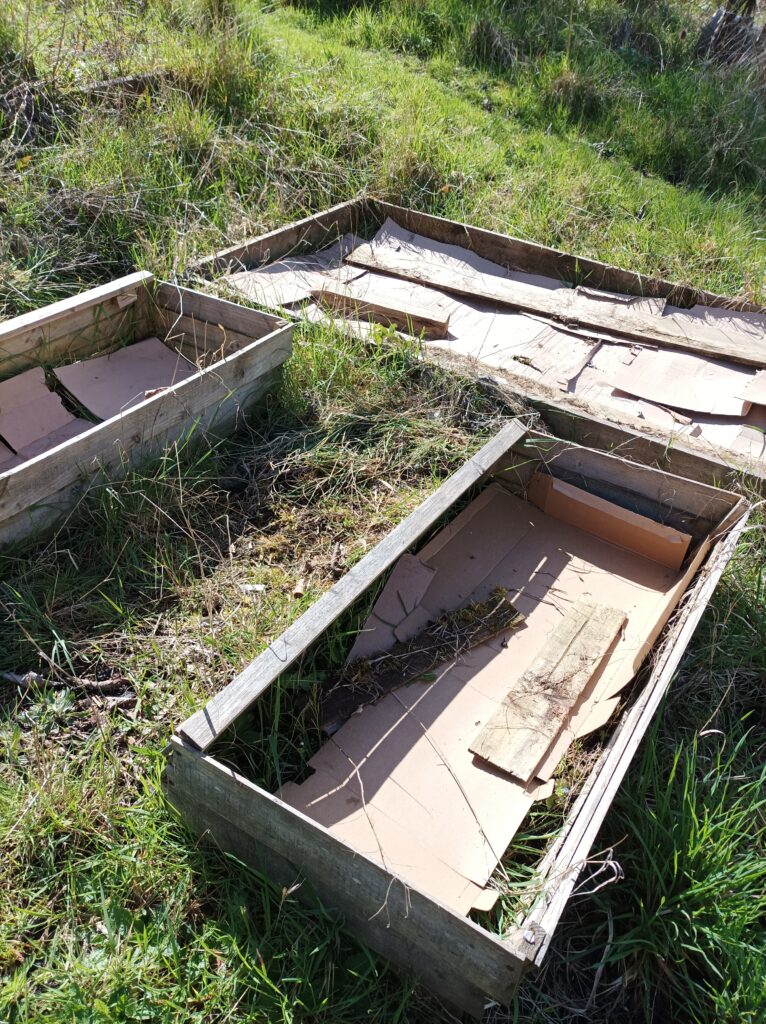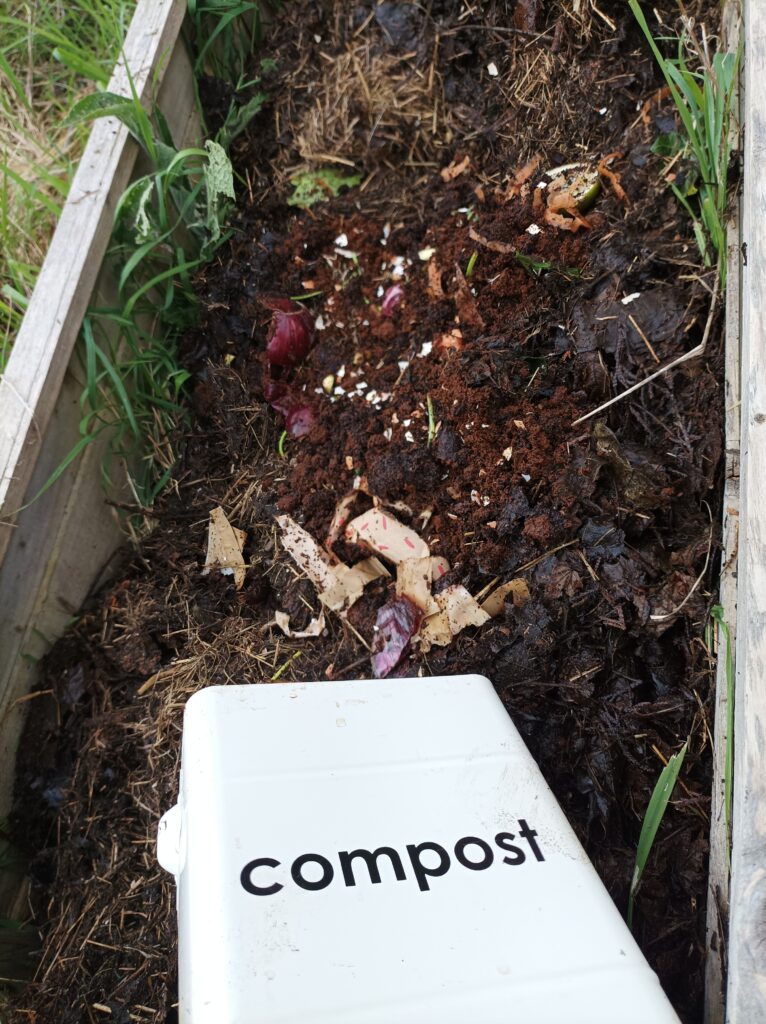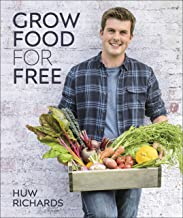When I took on Hen’s Tooth, I was keen to use sustainable practices when working the land. Healthy crops start with healthy soil.
The Importance of Soil
Soil health is an important aspect of agriculture and environmental sustainability. It plays a critical role in supporting the overall well-being of ecosystems. Soil degradation is a significant global issue that affects approximately one-third of the Earth’s land area. It impacts food production, biodiversity, water quality, and climate regulation. The topsoil layer is the most fertile part of the soil. This loss reduces the soil’s ability to support plant growth and agriculture.
Healthy soils have good water infiltration and retention capacities, allowing them to absorb and store water. Soil health supports diverse ecosystems by providing habitats for a wide range of organisms, including bacteria, fungi, insects, and earthworms. These soil organisms contribute to nutrient cycling, decomposition, and pest control. Preserving soil health helps protect biodiversity and ensures the sustainability of ecosystems.
We still have so much to understand about what goes on in the soil beneath our feet. Science is just scratching the surface (pun intended) of the complex relationships between microorganisms, fungus and a plants.
Mycorrhizal Networks
Fungal networks supporting plant life are often referred to as mycorrhizal networks. Mycorrhizal networks are found in various ecosystems, including forests, grasslands, and agricultural systems. They have been shown to enhance plant growth, improve nutrient efficiency, and contribute to ecosystem resilience. The fungal hyphae, which are thin, thread-like structures, extend far beyond the reach of plant roots, enabling them to explore a larger soil volume. The hyphae can access nutrients such as phosphorus, nitrogen, and micronutrients, which may be otherwise inaccessible to the plant. In return, the fungi receive sugars and other organic compounds from the plants, sustaining their own growth and reproduction.
Healthy soils act as a carbon sink, sequestering carbon dioxide from the atmosphere. By storing carbon in the soil, it helps mitigate climate change by reducing greenhouse gas emissions.
Soil health is critical for sustaining plant growth and productivity, as well as for maintaining the long-term health of agricultural and natural ecosystems.
Good soil management practices – such as ‘no dig’ gardening or ‘no till’ agriculture – increase biodiversity and improve soil health.
What is ‘No Dig’?
No-dig gardening is a method of gardening that involves growing plants without disturbing the soil by digging, plowing or tilling.
Promoting soil health, building nutrient layers into the soil – ‘feeding’ the soil, not the plant – and leaving those clever little mycorrhizal networks undisturbed.
Instead of digging or turning over the soil, a layer of organic matter is added on top of the soil surface, which decomposes and creates a nutrient-rich layer for the plants to grow in. This layer of organic matter can include materials like compost, leaves, straw, or grass clippings.
The idea behind no-dig gardening is to work with nature rather than against it, by preserving the soil structure and promoting the growth of beneficial microorganisms.
This method of gardening can help to improve soil health, reduce weed growth, conserve water, and save time and energy. No-dig gardening is a sustainable and environmentally-friendly approach to gardening that can lead to healthier plants and better yields.
The History of No Dig
The concept of no-dig gardening has been around for centuries, and has been used by various cultures around the world.
However, the modern form of no dig gardening that we know today was popularised by Charles Dowding, an organic gardener in my part of the UK, the Westcountry.
In the 1980s, Dowding began experimenting with a no dig approach to gardening and found that it improved soil health, reduced weed growth, and led to higher yields. He went on to write several books on the subject, including “Organic Gardening: The No-Dig Way“.
Today, no dig gardening is widely recognised as a sustainable and effective approach to gardening that can lead to healthier plants and improved soil health.
“Discover the joy and ease of no dig – Grow plentiful, healthy food while helping the soil & the planet”
Charles Dowding – no dig: HOME – Charles Dowding
Why No Dig?
When I mentioned to fellow allotmenteers that I’m trying to do no dig, I have been regarded with suspicion, even contempt.
The conventional method is to dig nutrients into the soil, which can work to improve yields in the short term, but is also labour intensive. By constantly disturbing the soil, it doesn’t have time to recover and settle leading to nutrient and moisture loss and the escalating spiral of frequent reapplication of ferlitisers.
Ultimately this leads to soil degradation, erosion, loss of biodiversity and releasing carbon into the atmosphere. An expensive, labour intensive, and destructive approach in the long term. Who am I to judge other allotmenteers’ approach? But I want to use my little patch of land more sustainably.
No Dig Benefits
Here are some benefits of no-dig gardening:
- Improved Soil Health: No-dig gardening helps to improve soil health by preserving the soil structure and promoting the growth of beneficial microorganisms. It also reduces soil erosion and compaction.
- Increased Yield: Plants grown in a no dig garden tend to have a higher yield because the soil is rich in nutrients and has a better structure, allowing the plants to grow more roots and absorb more nutrients.
- Reduced Weeds: By adding a layer of organic matter on top of the soil, helping to suppress weed growth. It also reduces the need for environmentally damaging herbicides.
- Water Conservation: Helping to conserve water by improving the soil’s ability to retain moisture. Useful when the weather is dry and I can’t get out to the allotment for a few days. The organic matter on top of the soil helps to prevent evaporation and reduces the need for frequent watering.
- Saves Time and Energy: Less labour intensive than traditional gardening methods, as it eliminates the need for tilling, digging, and weeding. This means less time and energy spent maintaining the garden.
My Reasons
There are three big reasons for me to use the no dig method at Hen’s Tooth:
Firstly
I’m quite lazy. I don’t want to create unnecessary and back-breaking work for myself by having to double dig and turn over heavy clods of claggy soil.
Secondly
I want to eliminate toxic waste, like chemicals and single use plastic. I’ll be using any organic scraps I can to feed my beds. I won’t be suppressing weeds with layers of plastic and I won’t be buying noxious, poisonous, plastic packed chemicals to fight nature on my plot. I can reuse compost bags, plastic pots etc. but it’s better not to have the waste all. Our world is literally choking with unnecessary plastic. Every decision I make that leads to less plastic being produced in the first place is the best I can do. Growing my own food and flowers, and reusing waste are solid places to start.
Thirdly
I don’t have loads of money to throw at my allotment. For me, the point (and the joy) of an allotment is to make do, to reuse, recycle and repurpose. I want to be creative, sustainable and experimental. The weird little projects and experiments that my limited space at home doesn’t allow for, I can do at Hen’s Tooth. Playing with off grid concepts and makes. Using the bits and scraps, left over paint, resources, and waste from DIY projects at home.
No Dig and Hügelkultur
The problem with the no dig method is the regular reapplication of layers of material on your soil to ‘feed it’. Avoiding plastic waste and saving money means I won’t be buying loads of bags of compost. I’ll need to get some in the first couple of growing seasons, to allow time for my own compost heap to develop, but the less of it I buy the better.
As the site is sloped, there are terraces and raised beds along it. I need to top up those beds, suppress weeds and retain moisture so I am using the Hügelkultur method to supplement my no dig approach.
I’ve started by cutting back tall weeds and grasses then layering cardboard over the beds.
This was the first thing I did when I took on the plot. The weeds will die down until I’m ready to prepare the beds.

Hügelkultur involves layering compostable matter like a lasagna. Start with larger scraps, like wood, at the bottom, then shredded up paper and cardboard, fruit and veg scraps and peelings, and then a top dressing layer of compost. The idea being that the layers will gradually break down and improve the soil.
Effectively, I’m growing directly on top of a compost heap and not wasting lots of money on buying soil and compost.

The term “Hügelkultur” originates from the German words “hügel” meaning mound or hill, and “kultur” meaning culture or cultivation. It has been used for centuries in German and Eastern European agriculture. The method has gained popularity in permaculture and sustainable gardening practices worldwide.
Here’s how Hügelkultur works:
- Building the Mound: Hügelkultur starts by creating a mound with logs or branches as the base layer. This base layer provides several benefits, including improved drainage, aeration, and moisture retention. Or in my case, filling my raised beds.
- Layering Organic Material: On the base layer, add organic materials like leaves, grass clippings, straw, kitchen waste, and compost. These materials can be collected from the surrounding area or sourced externally. The layers gradually break down, creating a nutrient-rich and moisture-absorbent environment.
- Planting and Mulching: Once the layers are in place, the Hügelkultur bed is ready for planting. Seeds or transplants can be placed directly into the mound. A layer of mulch, such as straw, on top retains moisture and suppress weed growth.
Sourcing Organic Matter
Because I’m a bit of a Womble*, I keep, and forage, things that could be useful.
*The Wombles: For the benefit of non-UK readers or people under the age of about 30. The Wombles was a children’s TV show about creatures living on Wimbledon Common, recycling and repurposing human rubbish… “Things that the everyday folk leave behind…”
Six Tips
Here are my tips for sourcing organic matter to fill your no dig beds:
- Who do you know? My neighbour has a wholesale plant business – The Bloom Room. I randomly acquire plants that are too sorry and sick to be sold, spent compost and whatever is going to waste. Who do you know with access to resources that would otherwise go to waste?
- What can you save at home? If you don’t already, start saving all your kitchen and garden scraps. Any uncooked food, veg and fruit peelings, pruning’s, grass clippings, tealeaves and coffee grounds, eggs shells etc.
- What can you rescue? When you see skips outside people’s houses, ask first, but is there any soil etc. you can make use of? Most coffee shops have bags of spent coffee grounds to get rid of. Ask and they will happily give it to you (they pay to have the waste removed otherwise).
- What can you scavenge? ask your friends and neighbours to give you their kitchen and garden waste.
- What can you get for free (or low cost)? Keep an eye on online platforms like Facebook Marketplace, local Facebook groups, Gumtree, Freecycle etc.
- Start a compost heap – There is already a heap at my allotment, but I’ve not dared look into it yet. It’s currently covered in nettles and brambles! At some stage I need to cut back the spiky stuff and see what I have to work with! I’ll be rebuilding or starting a new heap, using pallets. This is a long term project, however, I won’t have any compost from it this season. But I’ll be adding to it as I go along. Next year I should have some lovely loamy compost from the heap.
This is also a great book filled with loads of tips. I recommend it. Before I had my allotment I read it. I will be rereading it and using it as a reference over the season.

*As an Amazon Associate I earn from qualifying purchases. This post may contain affiliate links.